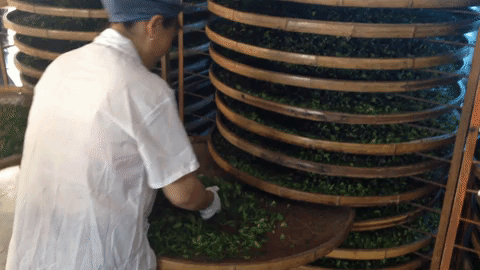
Scottericr
Shared posts
Oolong: More Than Mid-Oxidized
When introducing someone to the world of loose-leaf tea, I often describe oolong1 as being sort of in-between green tea and black tea. If a slightly longer explanation is appropriate, I describe the process of making black tea as oxidation (AKA enzymatic browning), where chemicals in the leaves turn brown after the leaves are crushed, and that green tea has been heated to prevent this chemical reaction from happening. Â Oolong has been allowed to experience a little bit of oxidation before heating, so it’s in-between. But in reality, this is a gross oversimplification. The differences between oolong and black tea processing are much greater than simply the amount of time oxidation happens, and there’s a lot of different things going on physiologically and chemically with the tea leaves.
To ensure that tea is completely oxidized in black tea processing, tea leaves are typically crushed or rolled strongly after withering to break open leaf cells and release their juices so that catechins mix with enzymes in the presence of air to ensure an even and complete oxidation. This reaction relies on enzymes and precursors that are already contained in the leaf cells. The crushing just allows them to mix and react with oxygen.
Oolong tea processing, on the other hand, does not generally involve crushing tea leaves, but rather starts with a gentler bruising, often called yáo qÄ«ng or “rocking the green”.  This may involve “fluffing” the withered leaves by hand every so often, or maybe placing the leaves in a large basket tumbler that rotates slowly.  Both of these actions only gently damage the leaf edges where they will gradually turn brown, while the inside of the leaf is still green.  Not only is the center of the leaf green, but it is alive during this step of processing. This, I’ve come to believe, is the major distinguishing feature of oolong tea, not it’s oxidation levels. This makes oolong tea more similar to white tea, which only undergoes a slow air drying, than to either green or black tea.

Oolong processing involves not only the oxidation of catechins in crushed leaf cells, but also a whole lot of other chemical reactions going on in the living, intact cells in the center of the leaf. These cells are experiencing a lot of stress—they’ve been severely wilted and their neighbors on the edge of the leaf are being damaged by yáo qÄ«ng—and this causes them to ramp up all sorts of chemical defenses. This is evident when you look at the gene expression (a measure of which and how many genes are turned up or turned down) of tea leaves undergoing oxidation in oriental beauty processing, reported by Cho and others in a 2007 research paper. They found thousands of genes were activated during yáo qÄ«ng—many of them associated with stress. Many of these genes were responsible for encoding the production of enzymes that make aroma chemicals.
In other words, tea leaves undergoing yáo qīng sensed damage that would ordinarily come from something eating them, and in a last-ditch effort they produced a bunch of defense chemicals that just happen to be really tasty to humans. Many of the genes that were activated in oolong production require intact, living plant cells to do their jobs, which are much more abundant in oolong processing compared to black tea processing where many more leaf cells are ruptured by rolling or crushing the leaves.
Cho and others also measured the aroma chemicals in leaves throughout processing and saw that many aroma chemicals increased dramatically during processing, some up to 400 times greater than in fresh leaves. Â In my own preliminary research comparing tea leaves before and after processing, many important aroma chemicals increase in concentration as a result of processing in oriental beauty tea including methyl salicylate, which not only contributes to tea flavor (it’s the main flavor constituent of wintergreen), but is also an important plant hormone produced by plant cells after sensing damage.
Rather than simply being differentiated from green and black teas by what percentage of the catechins are oxidized, I’d argue that there is a more important distinguishing characteristic of oolongs. Many of the floral or fruity aromas of oolong teas that make them so alluring might be produced “from scratch” by living cells in tea leaves during the slow, methodical processing of oolong teas. The fact that oolong leaves are alive (and stressed) for longer than green or black teas is what makes them more than just “mid-oxidized”.
Acknowledgements:
I’d like to thank Dr. Yang Zi-Yin from the Chinese Academy of Agricultural Sciences (CAAS) for inspiration and Dr. Li Xin from the Tea Research Institute in Hangzhou for taking pictures of Dr. Yang’s talk for me, translating it, and discussion.
Citations:
Cho J-Y, Mizutani M, Shimizu B-I, et al (2007) Chemical Profiling and Gene Expression Profiling during the Manufacturing Process of Taiwan Oolong Tea “Oriental Beauty.†Bioscience, Biotechnology and Biochemistry 71:1476–1486. doi: 10.1271/bbb.60708
Footnotes
1 The correct Pinyin transliteration for this word is “wulong”, but I’ve chosen to use “oolong” because it’s probably a more common spelling in English speaking countries.
The post Oolong: More Than Mid-Oxidized appeared first on Tea Geek Blogs.
Evolutionary Interactions Between Visual and Chemical Signals: Chemosignals Compensate for the Loss of a Visual Signal in Male Sceloporus Lizards
Abstract
Animals rely on multimodal signals to obtain information from conspecifics through alternative sensory systems, and the evolutionary loss of a signal in one modality may lead to compensation through increased use of signals in an alternative modality. We investigated associations between chemical signaling and evolutionary loss of abdominal color patches in males of four species (two plain-bellied and two colorful-bellied) of Sceloporus lizards. We conducted field trials to compare behavioral responses of male lizards to swabs with femoral gland (FG) secretions from conspecific males and control swabs (clean paper). We also analyzed the volatile organic compound (VOC) composition of male FG secretions by stir bar extraction and gas chromatography-mass spectrometry (GC-MS) to test the hypothesis that loss of the visual signal is associated with elaboration of the chemical signal. Males of plain-bellied, but not colorful-bellied species exhibited different rates of visual displays when exposed to swabs of conspecific FG secretions relative to control swabs. The VOC composition of male Sceloporus FG secretions was similar across all four species, and no clear association between relative abundances of VOCs and evolutionary loss of abdominal color patches was observed. The emerging pattern is that behavioral responses to conspecific chemical signals are species- and context-specific in male Sceloporus, and compensatory changes in receivers, but not signalers may be involved in mediating increased responsiveness to chemical signals in males of plain-bellied species.
Bug-bitten teas: why are leafhoppers only sometimes a good thing?
For most crops, insect damage is a bad thing—both for yield and quality.  With tea, however, we have this somewhat unique case of the so-called “bug-bittenâ€Â teas where attack by an insect actually improves the quality compared to an un-attacked plant by inducing chemical changes that are said to improve the aroma of the finished tea.  Famous examples of this are Oriental Beauty (东方美人, dong fang mei ren), Concubine Wulong (贵妃, gui fei), and Honey-Aroma (蜜é¦ , mi xiang) black teas.  All three of these teas are originally Taiwanese, so is there something special about Taiwan?  Well, when you dive into the scientific literature on leafhoppers on tea plants, most of the studies done in Taiwan are on a species of leafhopper known as Jacobiasca formosana, while most of the studies in mainland China talk about a leafhopper known as Empoasca vitis.  So it seems safe to assume that maybe one of these insects causes “good†chemical changes in the tea leaves that increase the quality and the other species causes “bad†chemical changes that decrease quality, right?  Well, according to a few recent studies, it turns out there is very strong evidence that theyâ€
, mi xiang) black teas.  All three of these teas are originally Taiwanese, so is there something special about Taiwan?  Well, when you dive into the scientific literature on leafhoppers on tea plants, most of the studies done in Taiwan are on a species of leafhopper known as Jacobiasca formosana, while most of the studies in mainland China talk about a leafhopper known as Empoasca vitis.  So it seems safe to assume that maybe one of these insects causes “good†chemical changes in the tea leaves that increase the quality and the other species causes “bad†chemical changes that decrease quality, right?  Well, according to a few recent studies, it turns out there is very strong evidence that theyâ€ re all the same species (Empoasca onukii), so the leafhopper responsible for Oriental Beauty is actually quite widespread!
re all the same species (Empoasca onukii), so the leafhopper responsible for Oriental Beauty is actually quite widespread!
And itâ€ s not something specific about geography either, as farmers in mainland China are beginning to adopt this technique to produce bug-bitten teas as well. So why is it that insect damage is a good thing only for these few teas? Why arenâ€
s not something specific about geography either, as farmers in mainland China are beginning to adopt this technique to produce bug-bitten teas as well. So why is it that insect damage is a good thing only for these few teas? Why arenâ€ t there any bug-bitten green teas on the market?  Iâ€
t there any bug-bitten green teas on the market?  Iâ€ ve done a bit of thinking about this, and it seems like there are only a handful of ways to explain why leafhoppers are considered pests on green teas, but can improve the quality of some wulongs like Oriental Beauty.
ve done a bit of thinking about this, and it seems like there are only a handful of ways to explain why leafhoppers are considered pests on green teas, but can improve the quality of some wulongs like Oriental Beauty.
- The leafhopper causes the same chemical changes in all tea plants, but those changes are considered “good†in wulongs and “bad†in green teas.  Green teas and wulong teas obviously have different criteria for judging, so maybe what makes an wulong good is actually undesirable in a green tea. This seems unlikely to me since there is a lot of overlap in the list of characteristics that make green tea and wulong tea good, but it is certainly the simplest explanation for this phenomenon. It may also be a simple matter of leaf appearance which is more important for a green tea like Longjing where any blemishes are easy to see compared to an oxidized, twisted leaf tea like Oriental Beauty.
- The effect of the leafhopper depends on processing method. In this scenario, the leafhopper still causes exactly the same chemical changes in all tea plants, but those chemicals get modified by different processing methods to create differences in the processed tea. For example, a leafhopper might cause a tea plant to produce some compounds that when left   unoxidized—as they would be in a green tea—produce undesirable flavors, but when they are oxidized in wulong processing they become compounds with desirable characteristics in the finished tea.
- Leafhoppers do different things to different cultivars. Maybe different cultivars of tea plant respond differently to leafhoppers.  For example, maybe Longjing #43 defends itself by producing more caffeine (an insecticide), which would lead to a more bitter tea, but Qing Xin defends itself by producing hotrienol, a chemical that smells nice to us and maybe attracts predators of the leaf hoppers.*
-
Leaves of different ages react differently to leafhopper damage.  Ok, bear with me on this one. Most green teas are produced with only one or two leaves and a bud while most wulongs are produced with even older leaves included in the plucking. Maybe the leafhopper produces undesirable chemical changes in young leaves and desirable changes in older leaves.  Then, if you make a green tea, youâ€
 re only getting the bad changes, but if you pluck for an wulong, maybe the good changes outweigh the bad ones. Â This one might seem like a stretch, but research shows that it is common for young leaves to respond to damage differently (and more intensely) than older leaves, so I think this is entirely possible.
re only getting the bad changes, but if you pluck for an wulong, maybe the good changes outweigh the bad ones. Â This one might seem like a stretch, but research shows that it is common for young leaves to respond to damage differently (and more intensely) than older leaves, so I think this is entirely possible.
I’m hoping that you—the knowledgeable tea buyers, farmers, and consumers of the tea world (AKA Tea Geeks)—can rule out some of these possibilities or maybe add some that I’ve missed.  Please let me know what you think in the comments!
*These are just examples! Leaf hopper damage has been shown to increase hotrienol concentrations in wulong cultivars, but as far as I know, no one knows what it does to caffeine or what leaf hoppers do to chemicals in green tea cultivars.
Image credit: By Hectonichus – Own work, CC BY-SA 3.0
The post Bug-bitten teas: why are leafhoppers only sometimes a good thing? appeared first on Tea Geek Blogs.
Chinese Millionaire Guangbiao Chen Wants to Buy The New York Times. This is His Business Card.
Substitutions
ScottericrIs there a chrome plugin to do this yet?

Singapore McDonald’s newest smelly treat: durian crunch McFlurry
What I love about McDonald’s in other countries is how they cater to the tastebuds of each country. I really miss the curry chicken McNugget dipping sauce in Singapore as well as the chili sauce packets! For all you durian lovers out there, Singapore McDonald’s just added another yummy (and stinky) dessert to their menu — the durian crunch McFlurry. Although other foods inspired by this pungent fruit, like the durian pizza, don’t sound quite as appetizing, this version actually sounds promising.
For $2.24, you can go get your durian fix in a cup with your order of burgers and fries!
Smuggled chicken feet from 1967 found in storage
To all you chicken feet lovers, I’m sure stumbling upon a storage filled with 20 tons of them would mean a feast—but probably not if you knew they dated back to 1967.
This is exactly what police discovered after they raided an illegal food storage site in Nanning, capital of the Guangxi. Apparently the site was run by a gang known to smuggle delicacies like chicken feet, beef tripe and cartilage from Vietnam across the border to Guangxi. Seven similar cases have been investigated by police in the past 12 months, and approximately over $3 million worth of illegal chicken feet have been seized.
A gang known for smuggling dim sum items? That sounds pretty badass to me!







